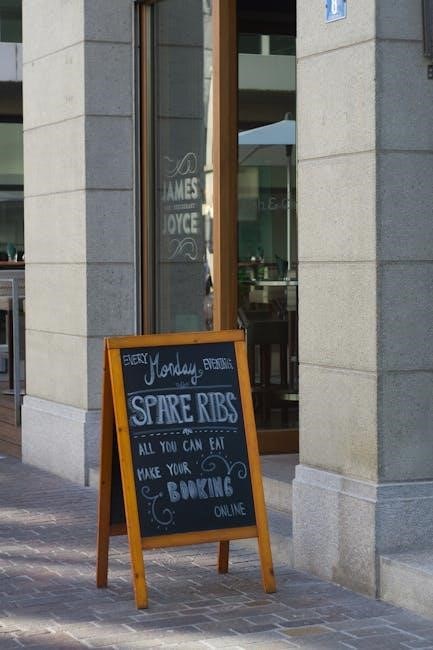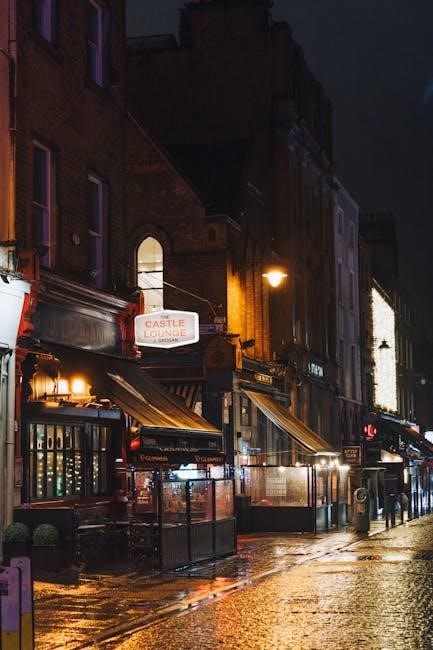Eveline, a short story from James Joyce’s Dubliners, explores themes of family, love, and escape. Published in 1914, it is available as a free PDF on platforms like Project Gutenberg, offering readers a glimpse into early 20th-century Dublin life through Eveline’s emotional journey.
1.1 Overview of the Short Story
Eveline, a short story from James Joyce’s Dubliners, revolves around Eveline, a young woman torn between her mundane life and the promise of escape with her lover, Frank. The narrative explores her internal conflict, family responsibilities, and the societal pressures that bind her. Joyce’s modernist style captures her emotional paralysis through stream-of-consciousness, offering a poignant glimpse into early 20th-century Dublin life and the struggles of self-discovery.
1.2 Historical Context of Dubliners
Dubliners, published in 1914, reflects early 20th-century Dublin society, capturing its social stagnation and personal paralysis. Joyce portrays the lives of Dublin’s middle class, highlighting their struggles with poverty, family dynamics, and societal expectations. The collection, including Eveline, offers a vivid portrayal of Irish life during a period of political and cultural change, providing historical insight into the experiences of ordinary people in Dublin.
1.3 Importance of “Eveline” in Joyce’s Work
Eveline holds significant importance in Joyce’s work as it exemplifies his modernist narrative techniques and themes of personal and societal paralysis. The story, part of Dubliners, offers profound insights into the inner lives of ordinary Dubliners, showcasing Joyce’s mastery of psychological depth. Its availability as a free PDF ensures accessibility, contributing to Joyce’s enduring legacy and allowing readers to connect with his exploration of human emotion and societal constraints.

Themes in “Eveline”
Paralysis, family dynamics, and the struggle for identity are central themes, reflecting Eveline’s internal conflict and societal constraints, as she grapples with escape and responsibility.
2.1 The Theme of Paralysis in Dubliners
Paralysis in Dubliners symbolizes the societal stagnation of early 20th-century Dublin. Characters like Eveline face emotional and psychological paralysis, unable to escape their mundane lives. Joyce portrays this through Eveline’s indecision, highlighting her fear of change and the oppressive nature of her environment. This theme underscores the broader societal issues of Ireland during that period, reflecting the collective inability to break free from stifling traditions and expectations.
2.2 Family Dynamics and Responsibility
Family dynamics in Eveline are marked by duty and obligation. Eveline, burdened by caring for her widowed father, feels trapped by her responsibilities. Her father, harsh and unappreciative, embodies the oppressive nature of familial expectations. This duty binds Eveline to her dreary life, making her hesitant to pursue escape. The story highlights how family obligations stifled individual aspirations, reflecting the societal norms of early 20th-century Ireland.
2.3 The Struggle for Escape and Identity
Eveline’s struggle reflects her desire to escape a life of drudgery and emotional confinement. Her relationship with Frank offers hope for a new identity, yet fear and obligation to her father trap her. Joyce portrays her paralysis as a inability to transcend her circumstances, symbolizing the broader societal constraints on women. Her internal conflict highlights the tension between duty and self-realization, central to her tragic inability to escape.

Characters in “Eveline”
Eveline, the protagonist, embodies emotional depth, while her father and Frank symbolize contrasting forces in her life. Minor characters amplify her internal conflict and societal pressures.
3.1 Eveline as the Protagonist
Eveline is the central character, a 19-year-old woman torn between duty and desire. Her narrative voice reveals deep emotional complexity, as she grapples with caring for her father and longing for escape. Joyce portrays her as both vulnerable and resilient, highlighting her internal conflict through vivid imagery and stream-of-consciousness. Eveline’s paralysis mirrors Dublin’s societal stagnation, making her a powerful symbol of unfulfilled potential and the struggle for identity.
3.2 The Role of Eveline’s Father
Eveline’s father represents both authority and vulnerability. His character, though often absent, shapes Eveline’s sense of duty and entrapment. Joyce portrays him as a widowed man relying on Eveline for care, creating a cycle of obligation. His presence underscores the societal expectations of family responsibility, contributing to Eveline’s internal conflict and inability to escape her circumstances, thus highlighting the oppressive nature of traditional family dynamics in early 20th-century Dublin.
3.3 Frank, the Lover, and His Significance
Frank, Eveline’s lover, symbolizes hope and escape from her oppressive life. A sailor, he offers Eveline a chance for adventure and a new identity. Frank’s presence highlights Eveline’s internal conflict between duty and desire. His significance lies in representing freedom and change, contrasting with the stagnation of her current existence. Ultimately, Eveline’s inability to leave with Frank underscores her emotional paralysis, emphasizing the story’s themes of entrapment and lost opportunities.

Plot Summary of “Eveline”
Eveline tells the story of a young woman torn between caring for her father and escaping with her lover, Frank. Her emotional struggle and final decision define the narrative.
4.1 The Opening Scene and Setting
The story begins with Eveline sitting at her window, watching the evening descend on the avenue. The odor of dusty cretonne fills her nostrils, and her tired state reflects her monotonous life. The setting, a dimly lit Dublin street, establishes a somber tone. Joyce’s descriptive language vividly portrays Eveline’s surroundings, immersing readers in her confined world and hinting at her emotional struggle with confinement and the desire for escape. The scene sets the mood for her internal conflict.
4.2 Eveline’s Inner Conflict and Flashbacks
Eveline’s narrative is marked by profound inner turmoil, as she grapples with the decision to escape her dreary life with Frank. Through flashbacks, Joyce reveals her childhood memories, her mother’s death, and her oppressive home life. These recollections intensify her emotional paralysis, highlighting her fear of the unknown and the comfort of familiar misery. Her internal struggle is deeply rooted in loyalty, duty, and the longing for freedom, creating a poignant psychological portrait. Joyce’s Stream-of-Consciousness technique captures her fragmented thoughts, mirroring her mental state and deepening the reader’s connection to her dilemma.
4.3 The Climactic Decision and Its Aftermath
Eveline’s climactic decision unfolds at the dock, where she faces a choice between escaping with Frank and remaining in Dublin. Despite her initial resolve, she freezes, unable to board the ship. This moment of paralysis culminates in her return home, symbolizing her surrender to the oppressive routines of her life. The aftermath leaves her trapped, reflecting Joyce’s theme of personal stagnation and the pervasive paralysis of Dublin society, as depicted in the story’s ending.

Modernist Elements in “Eveline”
Eveline showcases Joyce’s modernist techniques, such as stream-of-consciousness narration, capturing Eveline’s inner turmoil. Symbolism and imagery enrich the story, while the concept of epiphany highlights her emotional paralysis, all accessible in its free PDF format.
5.1 Use of Stream-of-Consciousness Narrative
Joyce employs stream-of-consciousness in Eveline, immersing readers in her thoughts and emotions. This narrative technique allows deep exploration of her inner conflict, blending past memories with present anxieties. The fluid, unstructured style mirrors her mental state, creating a vivid portrayal of her struggle, as detailed in the free PDF versions of the story available online.
5.2 Symbolism and Imagery in the Story
In Eveline, Joyce uses potent symbols like the “dusty cretonne” and “evening invade the avenue” to evoke her stifled life. These images reflect her emotional paralysis and longing for escape. The PDF versions highlight how such elements convey the tension between her domestic duties and desire for freedom, enriching the narrative’s emotional depth and thematic resonance.
5.3 The concept of Epiphany in Joyce’s Writing
In Eveline, Joyce employs the concept of epiphany through Eveline’s climactic decision. Her moment of realization, standing at the dock, embodies a sudden, profound insight into her trapped existence. PDF analyses highlight how this epiphany underscores her internal conflict, reflecting Joyce’s mastery of conveying emotional and psychological depth through subtle, yet powerful, narrative shifts.

Historical and Cultural Context
Eveline is set in early 20th-century Dublin, reflecting the city’s societal norms and cultural stagnation. Joyce’s portrayal of Eveline’s life highlights the restrictive roles of women and the pervasive influence of Irish nationalism during this period, offering a vivid backdrop to her emotional journey.
6.1 Early 20th-Century Dublin Society
Eveline is set against the backdrop of early 20th-century Dublin, a city marked by societal stagnation and cultural paralysis. Joyce portrays a society where rigid class structures and limited opportunities trap individuals like Eveline in cycles of duty and despair. The story reflects the stifling atmosphere of Dublin, where women’s roles were narrowly defined, and escape seemed impossible. This context underscores Eveline’s struggle between familial obligations and personal longing.
6.2 The Influence of Irish Nationalism
Eveline subtly reflects the influence of Irish nationalism through its portrayal of Dublin’s societal paralysis. Joyce critiques the cultural and political stagnation of early 20th-century Ireland, where nationalism coexisted with personal and collective immobility. Eveline’s inability to escape her circumstances mirrors the broader national struggle for identity and independence. This duality underscores Joyce’s exploration of how political and personal freedoms intertwine in shaping individual destinies.
6.3 The Role of Women in Irish Society
Eveline highlights the oppressive role of women in early 20th-century Ireland, where they were often confined to domestic duties. Eveline’s life, marked by caretaking and isolation, reflects the limited choices available to women. Joyce portrays her as trapped between familial obligations and the desire for escape, illustrating the societal constraints that stifled women’s independence and autonomy during this period.

Critical Analysis of “Eveline”
Eveline is a profound exploration of paralysis, societal constraints, and emotional turmoil. Joyce’s modernist narrative style immerses readers in Eveline’s psyche, revealing her inner conflicts and unspoken desires, offering a poignant critique of early 20th-century Dublin life.
7.1 Psychoanalytic Interpretation of Eveline
Eveline’s emotional paralysis reflects repressed desires and unresolved trauma. Her relationship with her father embodies the Oedipus complex, while her fear of escape with Frank symbolizes the struggle between old, familiar suffering and the unknown. Her final decision to stay highlights internalized oppression, suggesting a deeper psychological conflict rooted in societal and familial expectations, as well as unresolved grief over her mother’s death.
7.2 Feminist Perspectives on the Story
Feminist critics view Eveline as a symbol of oppressed womanhood, trapped by societal expectations and familial duties. Her inability to escape reflects the limited agency of women in early 20th-century Dublin. Eveline’s internal conflict mirrors the broader struggle of women confined by gender roles, highlighting the suffocating nature of patriarchal norms. Her decision to remain underscores the societal constraints that bind women to roles of care and sacrifice, denying them personal autonomy and freedom.
7.3 Marxist Critique of Class and Oppression
A Marxist interpretation of Eveline highlights the oppressive economic realities faced by the working class in Dublin. Eveline’s entrapment in poverty and domestic drudgery illustrates the exploitation inherent in capitalist systems. Her inability to escape underscores the cyclical nature of class oppression, where economic constraints perpetuate a lack of mobility and freedom. The story portrays the proletariat’s struggle, emphasizing how societal structures maintain inequality and limit individual potential.

Availability of “Eveline” in PDF Format
Eveline by James Joyce is widely available as a free PDF download on platforms like Project Gutenberg, Internet Archive, and various academic websites, ensuring global accessibility.
8.1 Free Download Platforms
Several platforms offer Eveline by James Joyce in free PDF format. Project Gutenberg, a leading digital library, provides a downloadable version. Additionally, Internet Archive and various academic websites host free PDFs of the story, ensuring easy access for global readers. These platforms allow readers to explore Joyce’s work without cost, making Eveline widely accessible for study and enjoyment.
8.2 Project Gutenberg and Public Domain Access
Project Gutenberg offers a free PDF of Eveline as part of James Joyce’s Dubliners, published in 1914. Since the story is in the public domain in many countries, it is widely accessible. This platform ensures that readers can download and read Eveline without cost, making Joyce’s work available to a global audience. Its public domain status facilitates easy access for educational and personal use.
8.3 Other Online Resources for the Story
Besides Project Gutenberg, Eveline is available on the Internet Archive and various educational websites. Platforms like Google Books and scholarly databases offer free or preview access to the story. Additionally, websites such as appohigh.org provide downloadable PDFs and analyses of Eveline, making it accessible for students and researchers. These resources ensure widespread availability of Joyce’s work for academic and personal use.

Stylistic Analysis of Joyce’s Writing
Joyce’s writing in Eveline features a stream-of-consciousness narrative, vivid imagery, and symbolic elements. His unique style captures the protagonist’s inner turmoil, blending realism with psychological depth seamlessly.
9.1 Use of Language and Syntax
Joyce employs a modernist style in Eveline, blending simplicity with poetic imagery. His concise, direct sentences reflect Eveline’s unadorned inner world, while vivid descriptions evoke her emotional paralysis. The narrative voice, often close to Eveline’s thoughts, creates intimacy. Joyce’s syntax, though sparse, captures the monotony of her life, using repetition and everyday language to convey her longing and frustration, mirroring the limited possibilities of her Dublin existence.
9.2 The Role of Irony in the Narrative
In Eveline, Joyce employs irony to highlight the protagonist’s tragic paralysis. Eveline’s decision to escape her dreary life is juxtaposed with her inability to act, creating situational irony. Her desire for freedom contrasts starkly with her eventual submission to familiar misery, underscoring the futility of her hopes. Joyce’s subtle use of irony emphasizes the societal and emotional traps confining Eveline, leaving readers with a poignant sense of unfulfilled potential and enduring regret.
9.3 Joyce’s Unique Narrative Techniques
Joyce’s unique narrative techniques in Eveline include stream-of-consciousness, immersing readers in her thoughts and emotions. He uses epiphany to reveal her inner turmoil, while symbolism, like the dusty cretonne, reflects her stagnant life. Joyce’s indirect narration and vivid imagery enhance the story’s emotional depth. These techniques, combined with the story’s availability as a free PDF, allow modern readers to explore his innovative style and thematic richness with ease.
Eveline remains a poignant reflection of early 20th-century Dublin life, offering insights into themes of family, escape, and identity. Its availability as a free PDF ensures timeless accessibility, preserving Joyce’s legacy for future readers to explore its emotional depth and narrative richness.
10.1 Relevance of “Eveline” Today
James Joyce’s Eveline remains relevant today due to its exploration of universal themes like family obligations, love, and the quest for identity. The story’s emotional depth and modernist narrative techniques continue to captivate readers, making it a vital part of literary studies. Its availability as a free PDF ensures accessibility for global audiences, preserving its impact and allowing new generations to engage with Joyce’s profound insights into human experience.
10.2 The Enduring Legacy of James Joyce
James Joyce’s legacy endures as a pioneer of modernist literature, with works like Eveline showcasing his innovative narrative techniques. His exploration of human consciousness and societal constraints remains influential, attracting scholars and readers worldwide. The availability of Eveline in PDF format through platforms like Project Gutenberg ensures his work remains accessible, solidifying his impact on literary history and continuing education in contemporary times.
10.3 Final Thoughts on the Story’s Impact
Eveline leaves a lasting impact through its poignant portrayal of personal and societal paralysis. Its exploration of themes like family, love, and escape resonates deeply, offering insights into early 20th-century Dublin life. The story’s availability in PDF format ensures its continued relevance, allowing readers to reflect on its universal themes and Joyce’s masterful storytelling, making it a timeless piece of modernist literature that endures in academic and cultural discourse.

References and Further Reading
Access Eveline as a free PDF via Project Gutenberg and Internet Archive. Explore academic analyses on JSTOR and Google Scholar for deeper insights.
11.1 Academic Sources and Essays
For scholarly insights, explore JSTOR and Google Scholar for essays analyzing Eveline. The story is also discussed in academic journals like James Joyce Quarterly and Modern Fiction Studies, offering critical perspectives on its themes and narrative techniques. These sources provide in-depth analysis for students and researchers seeking a deeper understanding of Joyce’s work.
11.2 Recommended Critiques and Analyses
Notable critiques of Eveline include feminist analyses by scholars like Suzanne Gilbert and psychoanalytic interpretations by Frederick Hoffmann. These critiques explore themes of gender roles and psychological paralysis, offering deeper insights into Eveline’s internal conflict. They are accessible via academic databases like JSTOR and provide valuable perspectives for understanding Joyce’s narrative techniques and character development.
11.3 Additional Resources for Study
For deeper exploration, Eveline is available as a free PDF on platforms like Project Gutenberg and Internet Archive. Scholarly articles on JSTOR and Google Scholar provide critical insights. Supplementary materials, such as lecture notes from university websites, and study guides like CliffsNotes and SparkNotes, further enhance understanding of the story’s themes and Joyce’s literary techniques.

